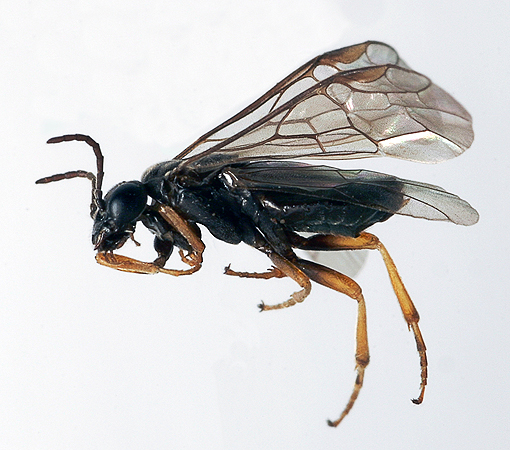Pests
Hoplocampa minuta Christ. - Black Plum Sawfly
Systematic position.
Class Insecta, order Hymenoptera, family Tenthredinidae, genus Hoplocampa Hartig.Synonyms.
Hoplocampa fulvicornis F.Biological group.
This is a pest of plum, cherry plum, apricot, sloe, cherry.Morphology and biology.
Adult body length is 4-5 mm. Head, thorax and abdomen are black in color. Antennae are 9-segmented, male antennae light-brown with black basal part, female antennae dark-brown. Apical margin of clypeus is weakly angularly emarginated. Wings are transparent with brownish veins. Ovipositor is shorter than hind tibia. Larva has 7 pairs of abdominal prolegs, yellowish-white in color, head brownish or orange. The larva has 5 instars. Scent glands appear in 2nd larval instar. Body length in last instar reaches 6-8 mm. The last instar larva hibernates in cocoon in soil at a depth of 3-10 cm. Cocoon is tight, elongated-oval. Pupation occurs in spring, at surface soil temperature 8°C. Pupa is free. Mass adult emergence occurs a week before the beginning of plum blossoming. Adult longevity is 8-15 days. Oviposition begins after adults feed on nectar and pollen of fruiters. Female scarifies epidermis of calyx with ovipositor and lays eggs one by one into fruitlet. Fertility is near 20-30 eggs. The temperature threshold of egg development is about 8°C, the degree days for the embryonic period is 36°. Larvae die out with a spring frost at temperature -4°C. After hatching the larva penetrates into fruitlet. Larvae develop over 21-24 days in Ukraine. During that period larva injure 3-6 fruitlets, crawling at night time.Distribution.
This species is distributed throughout Western Europe northward to Sweden. In the former USSR the species inhabits the European part, the Caucasus, and Uzbekistan.Ecology.
It is a mesophilous species. The pest predominates in humid regions of the forest-steppe zone. In the steppe zone it appears en masse after a previously humid year. Some of the larvae continue to diapause for 2 years. Damaged fruits fall prematurely to earth a week after the hatching of larvae. The last instar larvae fall to earth inside fruit, then leave the fruit to go into soil and make cocoons. Population density in nature depends on the activity of parasites of larvae, e.g.: Microbracon mokrzeckii Niez., Phygadeuon talitzkii Tel., Polyodaspis ruficornis Mcq.Economic significance.
Occasionally this species causes damage in Armenia and Georgia, having no economic significance in Uzbekistan. Sometimes after mass propagation of the pest losses of harvest reach up to 95%. Autumn plowing and disking between the tree rows are important preventive control measures against the H. minuta. Control measures after mass appearance of adults include double insecticide treatments in spring, during the balloon status of bud development, and immediately after blossoming.Reference citations:
Batiashvili I.D. 1959. Pests of continental and subtropical fruit crops. Tbilisi: Institut sel'skogo khozyaistva. 455 p. (In Russian)Ermolenko V.M. 1984. Family Tenthredinidae. In: Kopaneva L.M., ed. Keys to harmful and useful insects and mites on the fruiters and berry crops in the USSR. Leningrad: Kolos. 288 p. (In Russian)
Gusev V.G., Ermolenko V.M., Svishchuk V.V., Shmigovskii K.A. 1962. The atlas of insect pests of Ukraine. Kiev: Radyans'ka Shkola. 224 p. (In Ukrainian)
Mirzoyan S.A. 1970. Sawflies and horntails - the pests of bush and forest plantations of Armenia. In: Mardzhanyan G.M., ed. Collection of works of Armenian Institute of Plant Protection. V. 1. Erevan: Armenian Institute of Plant Protection. 95-118 p. (In Russian)
Popov V.V. 1949. Order Hymenoptera. In: Pavlovskii E.N., Shtakelberg A.A., eds. Pest Animals of Middle Asia (handbook). Moscow-Leningrad: AN SSSR. 404 p. (In Russian)
Savkovskii P.P. 1976. Atlas of the pests of fruit and berry plants. Kiev: Urozhai. 207 p. (In Russian)
Tryapitsyn V.A., Zhelokhovtsev A.N. 1981. Order Hymenoptera, Suborder Symphyta. In: Narchuk E.P., Tryapitsyn V.A., eds. Insects and mites - pests of agricultural plants. V. 4. Hymenoptera and Diptera. Leningrad: Nauka. 221 p. (In Russian)
Vasil'ev V.P., ed. 1973. Pests of agricultural crops and forest plantations. V. 1. Kiev: Urozhai. 496 p. (In Russian)
Zhelokhovtsev A.N. 1988. Order Hymenoptera. Suborder Symphyta (Chalastogastra). Keys to insects of European part of the USSR. V. 3. Part 6. Leningrad: Nauka. 288 p. (In Russian)


